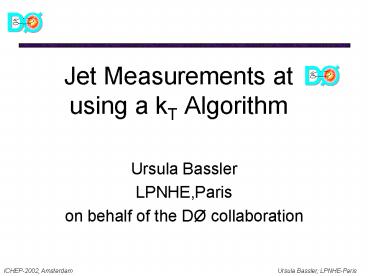Jet Measurements at using a kT Algorithm PowerPoint PPT Presentation
1 / 16
Title: Jet Measurements at using a kT Algorithm
1
Jet Measurements at using a kT Algorithm
- Ursula Bassler
- LPNHE,Paris
- on behalf of the DØ collaboration
2
Outline
- Introduction kT jet algorithm _at_ DØ
- ABS 350 Inclusive Jet Cross Section
Phys. Lett. B525 211, 2002
(hep-ex/0109041) - ABS 407 Sub-jet Multiplicities
- Phys. Rev. D65 052008, 2002
(hep-ex/0108054) - ABS 421 Thrust Cross Sections
Preliminary
D0 Run I Data at 1800 GeV
630 GeV Run IB (94-95) Run
1C (95)
90 pb-1 0.6 pb-1
3
- Calorimeter
y
q
j
x
Z
- Ur/liq. Ar calorimeter
- high granularity, good hermeticity,
quasi-compensated
- Transverse segmentation (towers)
Electrons sE / E 15 /ÖE 0.3 Pions
sE / E 45 /ÖE 4
h - ln tan (q / 2) h lt 4.2 l intgt
7.2 (total)
4
Run I kT Algorithm
- Jet Algorithms
- Fixed cone most DØ Run I results, all CDF
results - kT -algorithm New DØ Run I results
- fewer split-merge ambiguities,
- infrared safe to all orders in perturbation
theory.
Ellis, Soper Phys. Rev. D48 3160, 1993
Catani, Dokshitzer, Seymour, Webber Nucl. Phys
B406 187, 1993
For each object and pair of objects
order all dii and dij
If dmindij ? merge particles
If dmindii ? jet
5
Inclusive Jet Cross Section
- pQCD predictions, proton structure, quark
compositeness
Stat Errors only
dominant
kT algorithm (D1)
Tot. Err 14 (27) at 60 (450) GeV
6
Comparison with Cone Result
Each result is compared to its own NLO prediction
- kT vs. cone agreement is reasonable marginal at
low PT - NLO predictions ?(kT, D1) ?(cone, R0.7)
within 1 - the data is corrected back to particle level
- error correlations are large point-to-point in
pT, but largely uncorrelated between the two
measurements.
7
Hadronization effects
- particle jets are more (less) energetic than
parton jets with kT (cone) - kT collects more energy
- cone looses energy
- kT jets are 7 (3) more energetic at 60 (200) GeV
than cone jets - consistent with HERWIG at high pT, at 2? at low
pT
applying correction to cone-jets improves
agreement between the 2 algorithms
8
Comparisons with pdfs
- MRST nearly constant offset
- CTEQ4M improved description at high pT
- CTEQ4HJ better ?2, especially at high pT
all data points all data points all data points
pdf ?2(ndf24) prob()
CTEQ3M 37.6 3.8
CTEQ4M 31.2 15
CTEQ4HJ 27.2 29
pTgt 100 GeV only pTgt 100 GeV only pTgt 100 GeV only
pdf ?2(ndf20) prob()
CTEQ3M 17.4 62.7
CTEQ4M 15.8 72.7
CTEQ4HJ 15.1 77.3
9
Multiplicity in Quark Gluon Jets
- Test of QCD difference between quark gluon
jets - ratio of color factors of gluons radiated from
gluons/quarks 9/4 - multiplicity of objects in gluon/quark jets at
asymptotic limit - particles in a gluon jet are softer than in a
quark jet - Separate quark from gluon jets top, Higgs,
WJets events
at fixed Jet ET quark/gluon jet contribution to
the total x-section vary with ?s
- measure the sub-jet multiplicity in quark and
gluon jets
10
Sub-jets with the kT algorithm
- Merge criteria adjusted to study jet structure
- re-run kT algorithm on all particles already
assigned to a jet
Cone jet
D 0.5
kT jet
ycut10-3 ycut1 no splitting ycut0 no merging
- determine gluon jet fraction ƒg from MC
ƒ18000.59 ƒ630 0.33 (55ltETlt100 GeV) - sub-jet multiplicity defined as M fgMg
(1-fg )Mq - assuming sub-jet multiplicity independent of ?s
- extract gluon (Mg)/quark (Mq) sub-jet
multiplicities from data at 1800 and 630 GeV
11
Sub-jets in Quark Gluon Jets
- gluon jets have a higher sub-jet multiplicity as
expected - good description by HERWIG
- dominant uncertainties
- quark/gluon jet fraction, dependent on pdf
- jet energy scale
- result qualitatively in agreement with
resummation calculation from Forshaw Seymour
HERWIG1.91 ALEPH (ee-) 1.7 0.1
12
Event Shape Variable Thrust
- Event shape variables allow to
- study spatial distribution of hadronic final
states - test perturbative QCD, verify resummation
calculations - extract ?s
Thrust characterizes sphericity of an event
13
Thrust at hadron colliders
- difficulties underlying event, pile-up, multiple
interactions - define thrust from 2 leading jets in thrust T2
- thrust is not Lorentz invariant
- introduce Transverse Thrust T2T computed from pt
- x-sect in bins of ? Q2 on
parton level
14
Dijet Transverse Thrust x-section
- Disagreement with JETRAD calculation in 2
regions - ?2/2 ? T2T ? ?3/2 LO calculation is O(?s4) ?
NLO calculation? - limit (1-T) 1 ? emission of soft and collinear
gluons ? logarithmic terms in ln(1-T) ?
resummation?
15
Summary
- DØ has successfully implemented and calibrated a
kT jet algorithm in a hadron collider - comparison of the kT x-section, cone x-section
and NLO calculations at low pt opened a
discussion on matters such us hadronization,
underlying event and algorithm definition - quark gluon jets have a different structure,
consistent with HERWIG predictions - thrust distributions offer an excellent
opportunity to test the recently developed NLO
3-jet generators - Further measurements to come using Run 2 data
16
Systematic Uncertainties
(2nd Bin)

